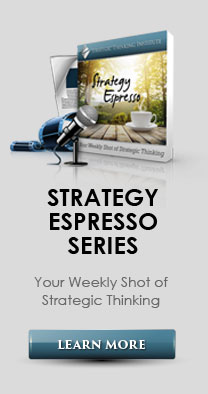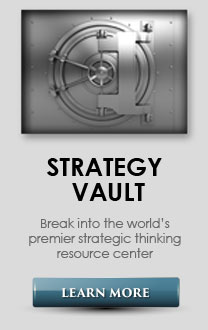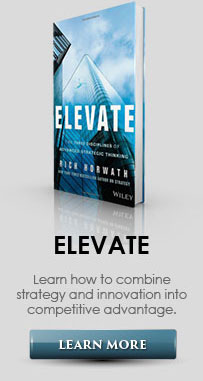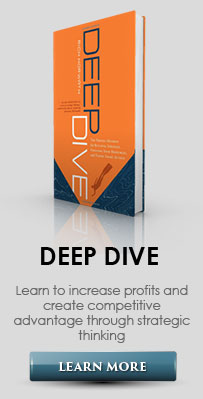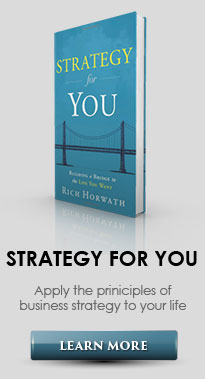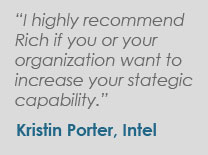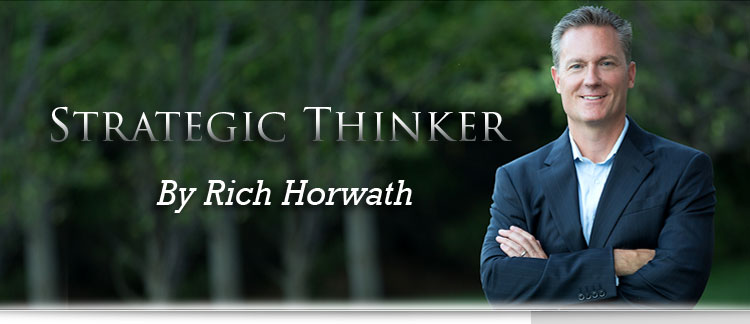
What Are You Missing?If you lead a team, manage a brand, head up a field sales force or set direction for the company, you've most likely experienced a "What's Missing Moment" (WMM). As an entrepreneur, most of my WMMs seem to come around 3:00 a.m. when I'll awake with a crystal-clear thought of something I'm missing in my business. Most recently I awoke and realized that I was missing an opportunity to double the sustainability phase of strategic thinking development from one year to two years, giving managers 100 learning touch points to transform this skill into an ingrained habit. What's your most recent "What's Missing Moment"? One of the reasons people maintain a high "busy rate" is that it can be frightening to consider what we're missing—where our blind spots reside. While it may be comforting in the short term to keep our minds occupied with the to-do list, it's often the things that managers miss that cause business failure. Nokia missed the first-mover advantage to market mobile phones with touchscreens even though they had developed a touchscreen phone seven years prior to Apple's introduction of the iPhone. Blockbuster missed the decision to allocate significant resources to an online offering even after Netflix offered to sell themselves to Blockbuster for a mere $50 million. What are you and your team missing that could lead to your business failure? A survey of 190 executives asked how prepared they were for changes in the economic environment and only one leader replied, "totally prepared," while 32 percent said, "totally unprepared." Another survey of 500 executives showed that 90 percent believed they were missing major opportunities in the market. So, how do we ensure that we're doing the best we can not to miss anything that could cause our business to fail? Plan. Let's start with what is not a plan. A stand-alone SWOT Analysis is not a plan. A to-do list of tactics is not a plan. A PowerPoint slide deck full of templates that no one uses during the year is not a plan. An Excel spreadsheet outlining this year's budget is not a plan. A list of customers or accounts is not a plan. These items may contribute in some form to a plan, but they are not, by themselves, a plan. A plan is a clear, concise and written guide of what you are trying to achieve and how you will achieve it. It typically includes a snapshot of the context or situation analysis; a review of customers, including those you have decided not to target; a description of the competitive landscape, focusing not just on competitor's products and services, but more important, on their strategies; and an honest assessment of the company, including the business model, value proposition and performance gaps. Ideally, a plan will also include the company's purpose in the form of mission, vision and values, along with the goals, objectives, strategies, tactics, milestones and metrics to gauge progress. In my experience reviewing hundreds of plans each year to help companies fine-tune them, what separates the great plans from the ones that go unused is the ability to take all this information and distill it into 1-2 pages. If a plan is 1-2 pages, it is much more likely to be updated, used and remain relevant. If it's not, it's a zombie and you've wasted the time doing it. As Brian Chesky, CEO of Airbnb said, "If you can't fit your plan on a page or two, you're not simplifying it enough." Here are three areas that are at the root of "What's Missing Moments" and if addressed, can go a long way in developing a better plan: 1. Trade-offs and the failure to reallocate resources. Many so-called strategies are not strategies at all because they're trying to be all things to all people. Strategy requires trade-offs and the ability to continually evaluate your "to-do's" and "not-to-do's." Senior leadership teams need to have strategy conversations on a regular basis that include the candid issue of what areas they are reallocating resources from and to so that they are maximizing their performance. Research has shown that 80 percent of managers say their senior leaders fail to kill unsuccessful initiatives quickly enough. If you're only reallocating resources once a year, you can be sure that you're falling behind the competition and leaving yourself open to missing good opportunities because your resources are tied up in things that simply aren't working. In fact, CEOs who reallocated the most resources in years 1-3 of their tenure were more likely to keep their jobs in years 4-6 than their colleagues who reallocated less. How often are you and your team reallocating resources? Eliminate the WMM: On a quarterly basis, re-evaluate your plan and specifically discuss which resources (people, time, projects, budgets) should be reallocated. The Trade-off Matrix is an effective tool for facilitating this strategy conversation. 2. Groupthink and the failure to use different perspectives. Groupthink occurs when there is a homogenous group of people with little influence from external perspectives and a high level of pressure to conform. Groupthink tends to reduce the level of objective thinking, remove devil's-advocate thinking, and punish those who attempt to do either. A leadership team that's been together for many years should have the advantage of a shared understanding of the business. However, this advantage can be squandered if they become complacent and comfortable with the status quo. Is groupthink a characteristic of your meetings? Eliminate the WMM: Research shows the most effective leadership strategy sessions are ones with a consistent core of members who sprinkle in people from other functional areas and use an objective facilitator with expertise in the strategy process. 3. Competition and the failure to understand competitor strategies. When you consider some of the more prominent companies that have gone into bankruptcy or experienced a significant stall out, it can often be attributed to not understanding their competitor's strategies. Back in 2001, the Nokia chairman said, "The mobile industry should remain under the control of the mobile industry and not the computer makers." Uh, OK. When Nintendo came out with their smash hit Wii gaming system, Sony's CEO said he saw it as a "niche game" but not a competitor. Oops. And when Apple introduced the iPhone, Microsoft CEO Steve Ballmer famously said, "No chance that the iPhone is going to get any significant market share." It's one thing to know a competitor's offerings, number of sales reps and what they gave away at their trade show booth last year. It's entirely different to know the competition at a granular level regarding their capabilities, value proposition, activities and how they are configuring their resources to achieve advantage in the market. A study published in the Harvard Business Review found less than 10 percent of managers consider their competitors' reactions into the formulation of their strategies. Does your team truly understand your most dangerous competitors' approach to winning business? Eliminate the WMM: Do a deep dive into the competitor's strategy profile by periodically examining their business model, including core competencies, capabilities, value chain, customer targets and differentiating activities to determine if you are at advantage, disadvantage or parity. To reduce the number of WMMs and help you determine the quality of your plan, take the 1-minute Plan Assessment at http://www.strategyskills.com/plan-assessment/. If your plan scores between 17-20, your team has given the business a great opportunity to succeed. If your plan scores between 13-16, your team is just a few adjustments away from being in a rock-solid planning position. If your plan scores between 9-12, your team is at a tipping point that can either swing toward marked improvement or a downward spiral. And if your plan scores below 9, your business is in jeopardy of being overwhelmed by market changes and competitive strategies like an inflatable pool float in a tsunami. Surf's up! |

